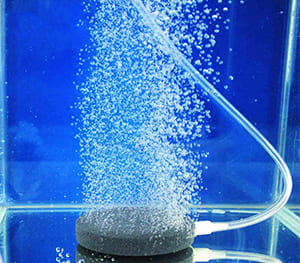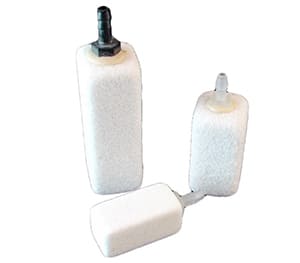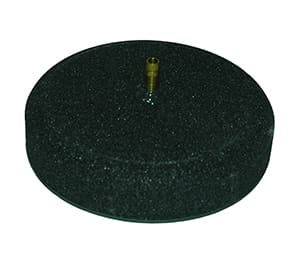Fish may leap out of the water in search of oxygen during the summer’s heatwave when the air becomes thick. They may become ill from oxygen deprivation or even suffocate. Thus, if you are wondering “Do I need air stones in my fish tank,” this is where an air stone comes to play its part! Fish distress can be avoided during these periods by adding air stones, which help maintain a constant oxygen supply.
Now let’s examine how important air stones are along with the benefits of air stones in aquarium and how do air stones work in fish tanks.
Disclosure: This article contains affiliate links. When you follow a link to purchase the products, I sometime earn a commission, at no additional cost to you. Read my full disclosure here
What is an Air Stone?
An aquarium bubbler, sometimes known as an air stone, is a useful tool that you can put in your fish tank to allow air to escape the water. It helps build water resistance, which is essential for your fish’s growth and muscular development, in addition to adding oxygen.
Air stones, which are usually made of porous stones or lime wood, disperse air evenly and silently, preventing the big bubbles that can cause problems in aquariums.

How Do Air Stones Work in Fish Tank?
Now, how do air stones work in fish tanks; well, the purpose of air stones is to add oxygen to water and enhance the bubble circulation in the tank. Air stones work by creating tiny, oxygen-filled bubbles that move around your fish tank’s air. In addition to increasing the oxygen content of the tank, these bubbles encourage water circulation by bringing different layers to the surface.
Different gases that are naturally released by the organisms in your tank are lifted out of the water by this circulation, which helps to maintain a healthier environment for your aquatic friends.
Types of Air Stones
It’s important to realize that air stones come in various sizes and shapes, each ideal for a particular use when selecting one for your tank. Let’s take a look at the two typical kinds:
1. Silica Air Stones
Available in a variety of sizes from 1 to 12 inches, silica air stones are commonly found in aquarium stores. These inexpensive, metal-free stones are commonly used in lab settings. Their drawback is that, with time, they might not be as durable.

2. Aluminum Oxide Air Stones
These stones function similarly to silica stones but are more durable and able to withstand repeated use and aggressive cleaning. These stones are usually found in larger ponds or industrial settings; however, because of their rough surface, which can scratch glass, they are not advised for use in glass aquariums.
The particular needs of your tank will determine which of these types is best for you. Aluminum oxide stones should be avoided if you have a glass aquarium to avoid any possible damage.

How to Use Air Stones in Fish Tank?
There is another common question among aquarium enthusiasts is how to use air stones in fish tank? So, let us tell you that aquarium air stones are easy to set up and use!
Simply adhere to these five easy steps for how to use air stones in fish tank:
- Select the Appropriate Air Stone: Choose a form and size that corresponds to your tank size.
- Connect to Air Pump: To connect the air stone to an air pump, use tubing that is safe for aquariums. Verify that the pump’s capacity fits the requirements of your tank.
- Place in Tank: Lower the air stone to the bottom of the aquarium by submerging it.
- Turn on the Pump: Turn on the air pump after it is connected and positioned.
- Watch and Modify: Assess the flow of bubbles. To get it just right, adjust the air pump setting or use a valve to regulate the flow if it’s too strong or too weak.
What Are The Pros And Cons Of Air Stone?
Although there are endless benefits of air stones in aquarium, just like every other thing, it also has some drawbacks. Have a look at the pros and cons of air stones;
Pros
- Enhanced Oxygenation: The best benefits out of all the benefits of air stones in aquarium is the increased oxygenation. Air stones provide a steady supply of oxygen for aquatic health, energizing enclosed spaces like aquariums. Especially important in systems where natural aeration is scarce.
- Better Circulation: The soft bubbles created by the air stones improve the movement of water in the tank, preventing stagnant spots and encouraging uniform nutrient distribution.
- Effective Aeration: By keeping anaerobic conditions at bay, air stones promote the decomposition of organic matter and lower the possibility of hazardous gas buildup in closed systems.
- Temperature regulation: Air stones help to maintain steady water temperatures by promoting heat exchange, which makes an ideal habitat for aquatic life.
- Healthy root systems: The benefits of air stones in aquarium do not end here as they also contribute to a healthy root system. Air stones provide vital oxygen to plant roots in hydroponic systems, promoting strong growth and effective nutrient absorption for the general health of the plant.
Cons
- Noise: People who share living spaces with a fish tank may find the audible sound of bubbling to be bothersome, particularly in quiet environments.
- Increased Evaporation: The bubbling action causes the water to evaporate more quickly, increasing the workload associated with maintenance and requiring more frequent tank refills.
- Disturbance for Certain Fish: The bubbles may cause stress or disruption for specific fish species, which could interfere with their natural behaviors. This is especially noteworthy for species that use bubbles to build their nests at the water’s surface.
- Equipment and Maintenance: Additional equipment such as air pumps, tubing, and check valves are required for air stones. Maintaining optimal performance and preventing clogs require routine cleaning.
- Water Agitation and Splashing: Air stones can cause excessive water agitation, which can cause splashing, which can disturb organisms that live on the surface of aquariums and cause water to evaporate.
- Energy Consumption: As air pumps run continuously, more energy is used, which eventually raises electricity bills.
Do I Need Air Stones In My Fish Tank?
Well, if you’re wondering; do I need air stones in my fish tank? Then we have got its two major purposes that are enough to answer your question. Have a look!
There are two primary uses for air stones. First of all, they improve the water’s oxygen content, which benefits your fish. They’re excellent at lessening the filtration system‘s noise as well. Air stones are inexpensive, require little upkeep, and last for many years.
Second, by producing bubbles, they improve the circulation of water. The filtration system is shielded from harm by placing an air stone at the bottom of the tank. Your fish will live in a healthy environment thanks to this. Air stones are essential in low-air pressure environments, such as on rainy days, to keep fish from suffocating.
Thus, air stones are certainly something very beneficial to your aquatic pets and their habitat. Stop thinking “Do I need air stones in my fish tank” and just go for it! Maintain the health of your aquarium with these easy-to-use, useful tools!
How to Clean Air Stones?
Keeping your aquarium’s air stone clean is essential to its health. Take these actions:
- Get the bleach solution ready: In a clean pot, mix 30ml bleach and 270ml water, making sure to use enough solution to cover the air stone.
- Take out of the aquarium: After turning off the air stone, remove it from the tank with caution. If it’s below the substrate, move it with your hands or a fish net.
- Immerse in the Bleach Solution: For two to three hours, submerge the air stone in the bleach solution. If the air stones are extremely dirty, adjust the soaking time.
- Wash and Pat Dry: Put on cleaning gloves, remove the air stone, and give it a good rinse. To prevent any damage to the air stone, place it on a towel and let it air dry completely.
Note that you can clean with substitutes like vinegar, fresh water, hydrogen peroxide, or cleaning tablets. Another option is to boil for ten minutes, but this is not recommended for acrylic materials.
What is the Difference Between an Air Stone and a Sponge Filter?
Sponge filters and aquarium air stones have different uses, even though they seem similar and both utilize air pumps. Whereas a sponge filter uses the air pump to filter out debris and promote the growth of beneficial bacteria, an air stone just releases air into the water.
How Long Does an Air Stone Last?
An air stone can last for a long time as long as it stays unclogged; after that, maintenance usually centers on the air pump. Cleaning all aquarium equipment, including the air stone, is generally recommended every six months.
Although there isn’t a set schedule for replacement, it’s a simple task if necessary because they are inexpensive and easy to replace.
Conclusion
Essentially, an air stone plays a vital role in dispersing air pumped into your aquarium. Although, they are typically small, blue, or black; how to use air stones in fish tank is quite easy and simple.
Consider, the heading of what are the pros and cons of air stones, and get ready to install air stone in your tank because the benefits certainly outweigh the cons.



